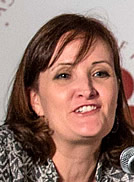Adding eltrombopag to standard severe aplastic anemia treatment improves responses for the first time in 30 years
Results of a phase II study, presented at ASH 2015, demonstrate that the addition of eltrombopag to standard treatment for severe aplastic anemia (SAA) notably increases the rate of complete hematologic response. This suggests that eltrombopag combined with immunosuppressive treatment (IST) may accelerate the rate and quality of hematopoietic recovery in patients with treatment-naive SAA. Moreover, the rapid blood count improvement and the reduced transfusion burden observed in this trial, support the early use of eltrombopag in this setting.
SAA occurs when the bone marrow does not produce enough new blood cells. Affected patients have anemia, thrombocytopenia, and neutropenia. They often feel tired and are at high risk of serious infections and bleeding. The standard of care for SAA patients consists of hematopoietic stem cell transplantation or IST with horse anti-thymocyte globulin (hATG) and cyclosporine. Despite efforts to improve outcomes for patients with SAA, response rates to IST have remained stable over the last 30 years. The rate of overall hematological response with IST is 60-65% and only approximately 10% of patients achieve a complete response. Eltrombopag is an oral medication that has been shown to improve blood counts in about 40% of SAA patients when used on its own. During ASH 2015, results of a phase II study were presented, examining whether adding eltrombopag to standard IST could further improve the response rate.
In the study at hand, 88 patients with previously untreated SAA were enrolled, after which they were divided into 3 cohorts of approximately 30 patients. All patients received standard IST with daily 150 mg doses of eltrombopag, administered for different intervals. In the first (N=30) and the second (N=31) cohort, eltrombopag was introduced after hATG, from day 14 until 6 months (cohort 1) or 3 months (cohort 2), due to initial concern of hepatotoxicity. In the third cohort, eltrombopag was given concurrent with hATG on day 1 and continued for 6 months (N=27). The primary endpoint of this study was the complete remission rate at 6 months.
In this study, eltrombopag was generally well tolerated with 2 patients discontinuing treatment for severe cutaneous reactions, and 6 patients withdrawing before 6 months due to refractoriness (N=4) or evolution to MDS (N=2). Across all cohorts, the complete remission rate at 6 months was 33%, 26%, and 54%, for cohorts one, two, and three, respectively. For all patients, this complete remission rate was higher compared to past studies with standard IST. The overall hematologic response rate was 80%, 87%, and 92%, respectively, for cohorts one, two, and three. All these rates were higher when compared to the historical rates (see keyslide 3).
In addition to this, all patients experienced a robust increased production of blood cells. The median time to transfusion-independence for platelets was 32 days and 42 days for red blood cells. For patients with severely low white blood cell counts, the median time to reconstitution to an adequate white blood cell count was 47 days. Serial bone marrow biopsies showed an improved cellularity in 80% of the cases, without increased fibrosis. The median increase from baseline in bone marrow CD34+ cells, as measured by flow cytometry, was 17-fold and 4-fold at 3 months for cohorts 1 and 2, respectively (p < 0.001).
In summary, the addition of eltrombopag to standard treatment notably increased the rate of complete hematologic response, suggesting that eltrombopag combined with IST may improve the rate and the quality of hematopoietic recovery in treatment-naive SAA patients. Moreover, the rapid blood count improvement and the reduced transfusion burden seen in this clinical trial support the early use of eltrombopag for patients with newly diagnosed SAA.
Reference
Townsley D, Dumitriu B, Scheinberg P, et al. Eltrombopag Added to Standard Immunosuppression for Aplastic Anemia Accelerates Count Recovery and Increases Response Rates. Presented at ASH 2015; Abstract #LBA-2.


